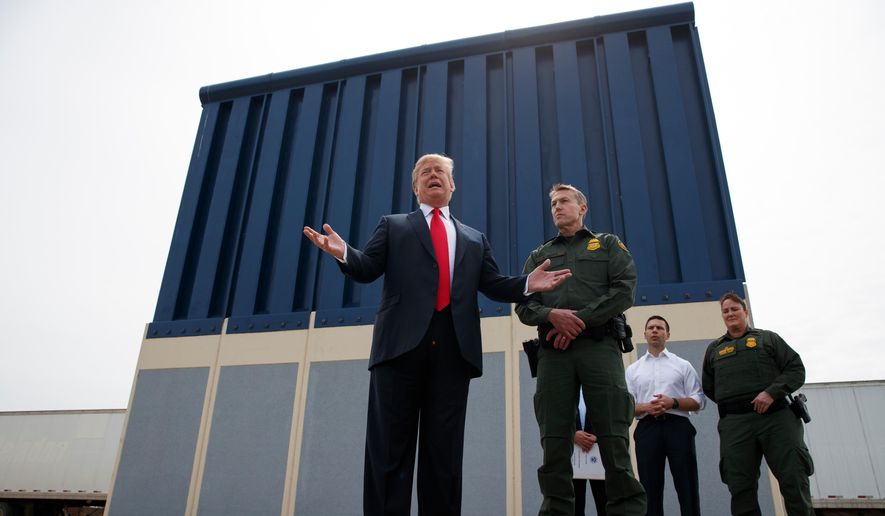SAN DIEGO (AP) - In vowing Tuesday to use the military on the U.S.-Mexico border until his coveted wall is built, President Donald Trump heaped blame on his predecessor, congressional Democrats and Mexico for creating a dangerous and dysfunctional border.
Here’s a look at some of Trump’s latest claims on the state of the border, including a caravan of Central Americans crossing Mexico, and how they stack up with the facts:
TRUMP: “President Obama made changes that basically created no border. It’s called catch and release. And we can’t do anything about it because the laws that were created by Democrats are so pathetic and so weak.”
THE FACTS: Wrong on several fronts.
In decrying what it calls “catch-and-release” policies, the White House cites a 2008 law that gave new protections to children who cross the border alone from countries other than Mexico or Canada. But the William Wilberforce Trafficking Victims Protection Reauthorization Act passed both houses of Congress unanimously with Republican President George W. Bush’s enthusiastic support.
The administration also points to a settlement of a class-action lawsuit in 1997 that established standards for detention, treatment and release of children who cross the border alone. Those protections have been extended by federal judges several times.
Over objections from the Obama administration, U.S. District Judge Dolly Gee in Los Angeles ruled that the settlement applies to children who come with their parents, as well as those who come alone.
Obama’s budget proposals for U.S. Customs and Border Protection grew 22 percent during his eight years in office to nearly $14 billion in his last year. The Border Patrol effectively ended its practice of turning Mexicans around without serious consequences, turning more often to formal removal orders in fast-track deportation proceedings or criminal charges.
Overall, Border Patrol arrests dropped during Obama’s tenure, despite surges in his second term. U.S. authorities were overwhelmed by unaccompanied children arriving at the border in 2014, predominantly fleeing violence and economic conditions in Central America, according to a U.S. Government Accountability Office report.
TRUMP: “I said (to Mexican officials), ’I hope you’re going to tell that caravan not to get up to the border.’ And I think they’re doing that, because, as of 12 minutes ago, it was all being broken up. We’ll see what happens.”
THE FACTS: Nothing is being broken up in Mexico. The caravan of largely Central American migrants never intended to reach the U.S. border, according to organizer Irineo Mujica. The caravan was meant to end at a migrant’s right symposium in central Mexico later this week.
The caravan stopped to camp at a sports field in the southern Mexico state of Oaxaca over the weekend, not because it was forced to by Mexican officials, but because it was a convenient place with welcoming local authorities and there were no logistics to take the estimated 1,150 people any further. On Tuesday, they waited to see how they can get to the central state of Puebla, perhaps by buses. Life goes on normally at the camp, with people heating simple meals over fires and sleeping under the stars.
All that Mexican immigration officers were doing at the camp was taking people’s names, to sign them up for temporary transit visas, which would allow them to travel to the U.S. border, possibly to seek asylum in the U.S., or to seek asylum status in Mexico.
TRUMP: “We really haven’t done that before, or certainly not very much before,” referring to deployment of U.S. military to the border.
THE FACTS: Sending troops to the border has been done for years, and at least one member of Trump’s own Cabinet has done it. In the summer of 2014, then-Texas Gov. Rick Perry, now serving as Trump’s energy secretary, ordered the deployment of 1,000 Texas National Guardsmen to the Rio Grande Valley, the busiest region for illegal border crossings. Perry gave the order in response to a sharp rise in the numbers of Central American children crossing the border alone.
About 100 of those Guardsmen remain on the border, Texas National Guard spokesman Lt. Col. Travis Walters said Tuesday.
In 2006, under Operation Jump Start, 6,000 troops were sent to the border in an effort to increase security and surveillance. The operation used the National Guard to assist the Border Patrol with non-law enforcement duties while additional border agents were hired and trained.
The number declined during the second year to about 3,000. Over the two years, about 29,000 National Guard forces participated in the missions, as forces rotated in and out.
__
Associated Press writers Jill Colvin in Washington, Nomaan Merchant in Houston and Christopher Sherman in Matias Romero, Mexico, contributed to this report.
Find AP Fact Checks at http://apne.ws/2kbx8bd
Follow @APFactCheck on Twitter: https://twitter.com/APFactCheck




Please read our comment policy before commenting.